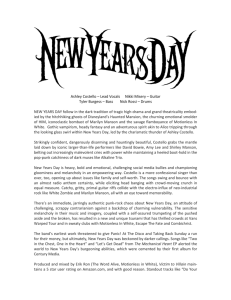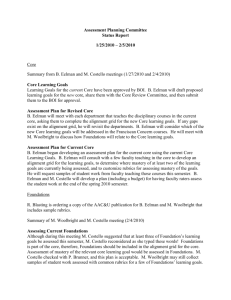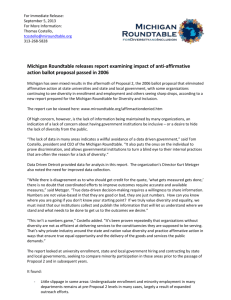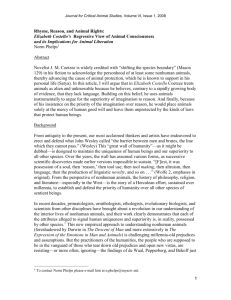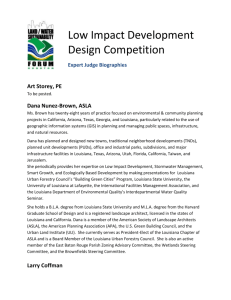Mea Ashley A Day in the Life of Brendan Costello The Art of the
advertisement
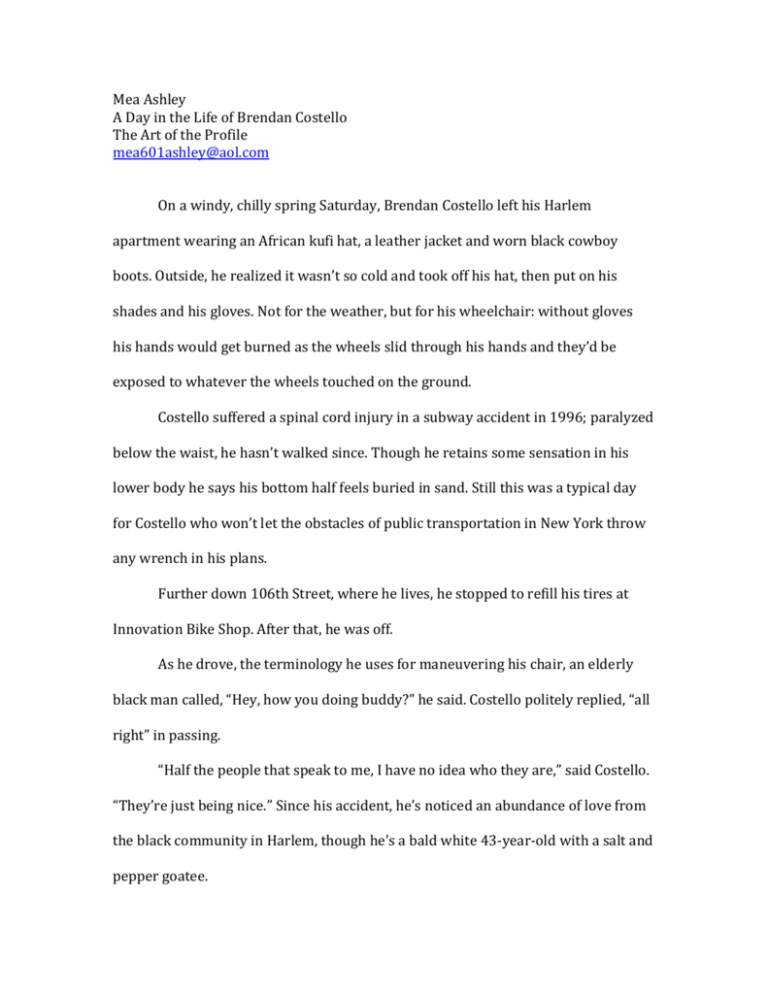
Mea Ashley A Day in the Life of Brendan Costello The Art of the Profile mea601ashley@aol.com On a windy, chilly spring Saturday, Brendan Costello left his Harlem apartment wearing an African kufi hat, a leather jacket and worn black cowboy boots. Outside, he realized it wasn’t so cold and took off his hat, then put on his shades and his gloves. Not for the weather, but for his wheelchair: without gloves his hands would get burned as the wheels slid through his hands and they’d be exposed to whatever the wheels touched on the ground. Costello suffered a spinal cord injury in a subway accident in 1996; paralyzed below the waist, he hasn’t walked since. Though he retains some sensation in his lower body he says his bottom half feels buried in sand. Still this was a typical day for Costello who won’t let the obstacles of public transportation in New York throw any wrench in his plans. Further down 106th Street, where he lives, he stopped to refill his tires at Innovation Bike Shop. After that, he was off. As he drove, the terminology he uses for maneuvering his chair, an elderly black man called, “Hey, how you doing buddy?” he said. Costello politely replied, “all right” in passing. “Half the people that speak to me, I have no idea who they are,” said Costello. “They’re just being nice.” Since his accident, he’s noticed an abundance of love from the black community in Harlem, though he’s a bald white 43-year-old with a salt and pepper goatee. Thirty minutes later than that, from 106th to 116th Street, Costello hopped off some curbs instead of using the curb cuts made for wheelchairs. Going off the raised sidewalk, he explained, is better when the curb has rotted out, creating a dip where water collects. “See, like right here, I could go through the puddle and my hands and or gloves would get wet, or I could go right here and I can make that small jump with no problem,” he said. Costello was injured at 27. He’d run on the track team as a kid, but calls himself a horrible athlete. “Go figure, I could go faster now than when I was growing up,” he said, on the way to the Malcolm Shabazz Harlem Market. He shops there every two or three months, or when the seasons change and he needs a lighter or heavier kufi. Approaching the market around 3 o’clock, he could hear live West African music from the courtyard. Vendors set up under tents, peddled all kinds of cultural knick-knacks: jewelry, colorful African garb, woodcarvings. Costello, in search of a copper bracelet, wheeled his 26-½ inch chair through the tight aisles, sometimes stopping to let others pass. At one point, he bumped into a stack of drums, knocking them over. He found the bracelet he was looking for at $5 after rummaging through two or three stations. He always buys more than he needs, “for support,” he said. “They’re a good business and I don’t want to see them go.” As he wrapped up half an hour’s shopping, his friend Gabriela Blanco-Bobea-or Gabby-- arrived and they found a sunny spot to enjoy the drummers and guitarists. “This is really cool,” she said, taking photos. She let down her long dark hair and wiggled her hips in her floral pants as Costello bobbed and nodded. Outside the market, they made their way to the Lenox Avenue and 125th subway station, where Costello knew there would be a working elevator. He checks the MTA’s website daily, the way some people check the weather. “Lets go to the other side of the street,” he told Blanco-Bobea. The sunny side was warmer, but it also allowed Costello to use his left arm more than his right, making it stronger. He dislocated his left shoulder in the accident when he passed out and fell onto the subway tracks. He doesn’t remember exactly what happened, but assumes the train ran him over and dragged him a few feet when his tie was caught under the wheels. Afterwards he spent months lying in Mt. Sinai Hospital, which is where he also did rehab. He couldn’t have remained as emotionally stable if his friends and family hadn’t kept reminding him who he was, Costello said. Some victims think they’re supposed to change after life-altering accidents. “There are some people who can’t get over, that they’ll still somehow be themselves,” he said. Prior to his accident, Costello worked at a news agency called Business News Wire. His job was very stressful but now he teaches creative writing at City College. He is much happier with his job now. Rolling onto the train around 5pm, Costello braced himself by holding on, to the pole, his legs outside it because his wheelchair’s brakes are “shot”. He’ll get a new one in a month through Medicare, which pays for a new wheelchair every five years, although only for certain kinds with fewer features. The train stopped at Grand Central Station and as he and Blanco-Bobea moved toward the elevator, his chair rolled slightly into the path of two elderly women. One looked somewhat annoyed. “I should’ve been more out of the way for those ladies,” Costello said. “Water under the bridge.” *** The Morgan Library on East 37th St. featured an exhibit called “Drawing Surrealism” that Costello wanted to check out. The building has an entrance ramp and accessible bathrooms, which makes him like visiting. Inside, the only sounds were footsteps on the hardwood floors and hushed voices discussing the art. Costello usually viewed the works from at least four or five feet away while Blanco-Bobea got closer to read the information panels. But a table display in the middle of the floor left room for Costello’s legs underneath, like the counter-tops in his kitchen. “That’s quite unpleasant,” he said, eyeing Max Ernst’s drawing of a man/bird stabbing a woman’s foot. They continued around the room until closing time at 6, discussing the art, Blanco-Bobea giggling from time to time at Costello’s wit. He drove along the 42nd Street sidewalk to get back to Grand Central Station. “Crowds standing still can be a pain in the ass, but crowds moving can also be a pain in the ass,” he’d said earlier about crowded sidewalks. People walk at a slower pace than his wheelchair moves, causing him to break momentum and continuously start and stop. Sometimes he wishes he had a horn to honk. The subway elevator smelled like urine, with a mysterious puddle just outside it. “I don’t know what it is about urinals these days; they look like elevators,” Costello said sarcastically. They took the 6 train to 125th for a concert at the Apollo Theatre. Costello steadying himself so he wouldn’t be “footloose and fancy-free.” Above ground, they stopped for something to eat at the Golden Krust, a Caribbean bakery and grill. To pay for the food, Costello had to reach above his head to hand the money over the high counters. A bit before 8, they entered Apollo’s smaller theater, which holds 150 and was almost filled. The small stage was packed with musicians-- guitarists, horn players, back-up singers, a drummer, string players, and the main event, soul poet and singer Carl Hancock Rux. At a high table in the back corner, Blanco-Bobea took a seat at a high table, and Costello sat low in his wheelchair, periodically lifting himself up to relieve pressure on his lower body. He shook his head to vibrant electric music, looked back at Blanco-Bobea and said, “That’s awesome!” Afterwards, on the way to the bus stop, Costello told about his first time at the Apollo. He’d transferred from his wheelchair to a great aisle seat on the fourth row to see George Clinton and the P-Funk All-Stars. When they came out, the entire audience was on its feet-- except for him. A woman behind tapped him indicating, “Get on your feet and jam!” and he couldn’t. He just sort of shrugged, as if to say, “I’m sorry I’m just really tired.” The M60 bus arrived and Blanco-Bobea got on. Costello waited for the ramp to unfold as the driver prepared him a place for him to ride. “Oh wow,” Blanco-Bobea who’s only been in New York for a couple months said as the ramp lowered. “I’ve never seen that before.” “Now you see it,” Costello said. “Watch yourself, I don’t want to run over you.” As they rode home, he pulled himself up from his chair, using the strap on the bars of the bus to release pressure. At their destination, not far from his apartment, he unlatched the front straps that held his wheelchair in place while Blanco-Bobea unfastened the rear. “My lovely assistant,” he said, as he replaced the standard bus seats and wheeled off.
